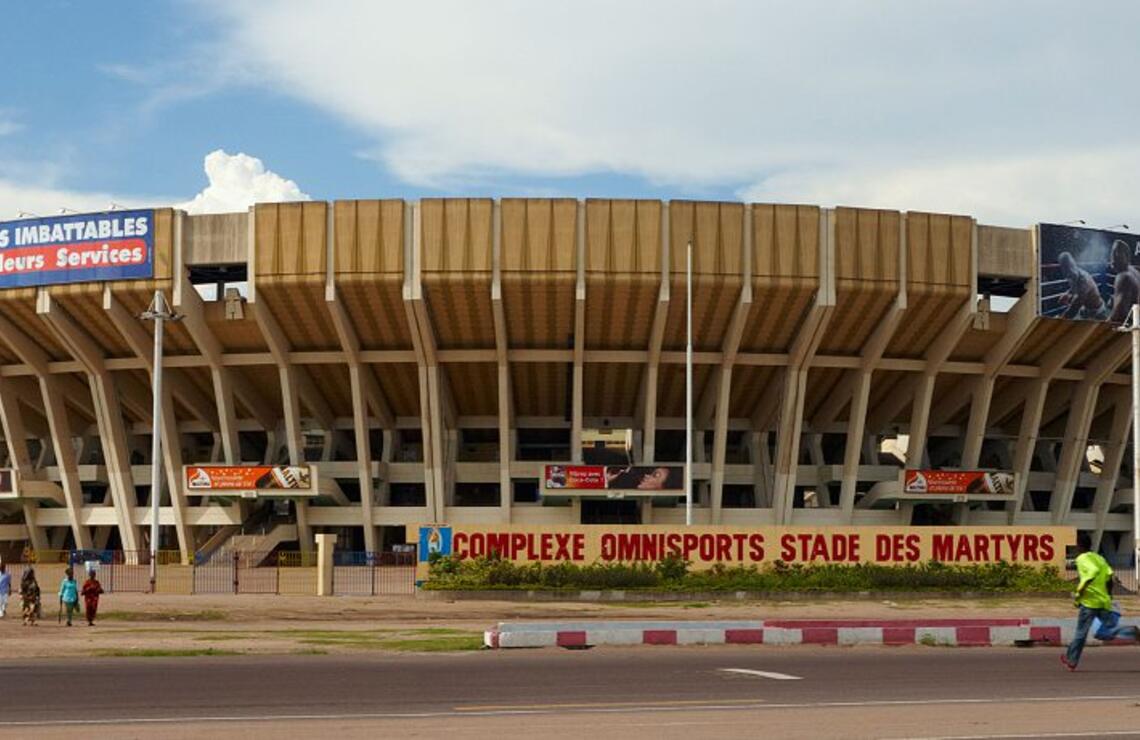
A stadium for rumba
and all the martyrs
There it is, in the centre of Kinshasa, a city of nearly 15 million people, and just a stone's throw from the no less famous Palais du Peuple, both urban monuments and testaments to cooperation with China. The Martyrs de la Pentecôte stadium (its official name) is the fourth largest in Africa, with its 80,000-seat capacity. And while it may not have been the stage of the legendary Rumble in the Jungle, the fight between Mohamed Ali and George Foreman in 1974, or the first footballing epic of the Leopards (winners of the African Cup of Nations in 1968 and 1974 and the first sub-Saharan African team to qualify for the World Cup), the ‘Grande Marmite’, as the people of Kinshasa call it, is central to the history and life of the country.
It is here that presidents are sworn in, and where Pope Francis celebrated mass on 2 February 2023. And above all, it's the epicentre of Congolese music, where the stars get the recognition they deserve from Kinshasa audiences. It's not enough to make it big in Paris, even at the Olympia, where Fally has performed, or in New York or elsewhere. To be consecrated, you have to perform at the Stade des Martyrs. A rite of passage that confirms one's status as an authentic star. An amazing story within the incredible history of this stadium.
Construction got under way on 14 October 1988, which also happened to be Marshal Mobutu Sese Seko's birthday. It was built on the rubble of Culturana, a legendary cultural venue from the 1960s to the 1980s, which was demolished to make way for the project. The project was delivered by China in 1994 and Mobutu named the stadium Kamanyola, after the town in South Kivu where his troops defeated the Simba rebellion in 1964. He also named his ship, a former Belgian colonial freighter, Kamanyola. The ship was often moored on the banks of the majestic Congo, in the Nsélé presidential park, where the Marshal liked to entertain guests on the aft deck, with the sun setting over the river and a glass of champagne in hand...
THE PLACE TO BE
On 17 May 1997, the Alliance des Forces Démocratiques pour la Libération du Congo (AFDL), backed by Rwanda and Uganda, marched across the country from east to west, toppling Mobutu Sese Seko's flagging regime. Laurent-Désiré Kabila renamed the stadium the Stade des Martyrs de la Pentecôte, as if to rewrite the country's history. The facts date back to 1966. A year earlier, Mobutu had overthrown President Kasa-Vubu and his Prime Minister Patrice Lumumba. On 1 June 1966, the soon-to-be marshal decided to have the Pentecost conspirators, Jérôme Anani, Évariste Kimba, Alexandre Mahamba and Emmanuel Bamba, four ministers in Lumumba's government who had become ‘opponents’ of the man still known as Joseph-Désiré Mobutu, hanged in public on the site of the future stadium. On 30 June 1997, Laurent-Désiré Kabila chose the stadium to make his first major speech.
As Congolese music grew in popularity, playing the Stade des Martyrs quickly became a major factor in establishing one's popularity and leadership status in the music world. Papa Wemba threw down the gauntlet by organising the Fula Ngenge festival in August 1999 to mark his fiftieth birthday, thirty years into his career. The phenomenal success of the event served as a challenge to the competitive Congolese rumba scene. A few months later, Wenge Musica Maison Mère, with Werrason and Bill Clinton Kalonji as their torchbearers, followed suit to fill the legendary stadium. Koffi Olomidé, at the top of his game, launched himself in 2003 with his legendary group Quartier Latin, already featuring the voice of a certain Fally Ipupa, to confirm that he was now number one in the big league. The group Wenge Musica, led by JB Mpiana and Werrason and which broke up in 1997, chose ‘Les Martyrs’ to seal its reconciliation with Wenge Musica BCBG 4x4 on 30 June 2022. Fally Ipupa, who has now taken control of his solo career, accepted the challenge in 2022 to assert his style, his rhythm, and his Tokooos, at the Stade des Martyrs.
It was a magical night. Nearly 120,000 spellbound spectators. An historic musical event. The Congolese writer Alain Mabanckou wrote on TikTok: ‘This concert acts as an official and irrefutable legitimisation of his artistic power. It was also a tragic night. Eleven people died in the stampede around and inside the stadium. Nine spectators and two police officers. A saturated stadium, counterfeit tickets, failings on the part of the organisers and the police. The blame was passed back and forth.
After a euphoric 2023, Fally wanted to come back, had to return to Kin, to Les Martyrs, for a double-date concert on 10 and 11 August. Ferre Gola, meanwhile, was preparing the first edition of the Festigola festival held from 2 to 4 August at the Tata Raphaël stadium in Kinshasa. There was rising tension. Fans took to the internet to challenge each other and mobilise the troops.
On 27 July, nine people were killed during a performance by one of the country's most famous gospel singers, Mike Kalambay. The overcrowding in the stands resulted in a disastrous crush. The authorities announced that they were opening an investigation to determine the circumstances of the tragedy. The Ministry of the Interior declared that all non-sporting activities were henceforth forbidden here, as well as at Tata Raphaël.
Fally's concerts were cancelled. Silence descended on the Stade des Martyrs. Those of 1 June 1966. And those who died here in the name of music.